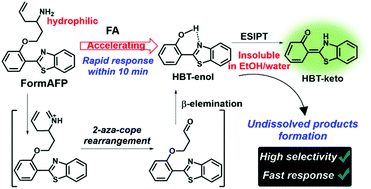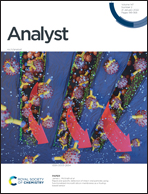A ratiometric ESIPT probe based on 2-aza-Cope rearrangement for rapid and selective detection of formaldehyde in living cells†
Abstract
Formaldehyde (FA) is a crucial reactive signaling molecule participating in epigenetic and metabolic pathways. However, abnormally elevated levels of FA are implicated in various diseases spanning from tumors to neurodegenerative disorders. Despite being highly selective for FA, current 2-aza-Cope-based fluorescent probes leave room for improvement because their relatively slow reaction kinetics (1–9 hours response time) hinder their capability to track transient biological FA. Herein, we present a ratiometric fluorescent probe, FormAFP, based on excited state intramolecular photon transfer (ESIPT) for rapid (within 10 min), selective (above 70-fold over other RCS) and sensitive (240-times fluorescence enhancement with 66 nM detection limit) detection of FA via 2-aza-Cope rearrangement. The probe also displayed a fast response (<20 min) to both exogenous and endogenous FA in living cells. Besides, FormAFP was capable of monitoring FA released by folate degradation in living MCF7 cells. More importantly, FormAFP successfully detected fluctuations of endogenous FA levels in oxidative stress stimulation, demonstrating its potential as an ideal tool to explore FA biology.

- This article is part of the themed collection: Analyst HOT Articles 2021


 Please wait while we load your content...
Please wait while we load your content...